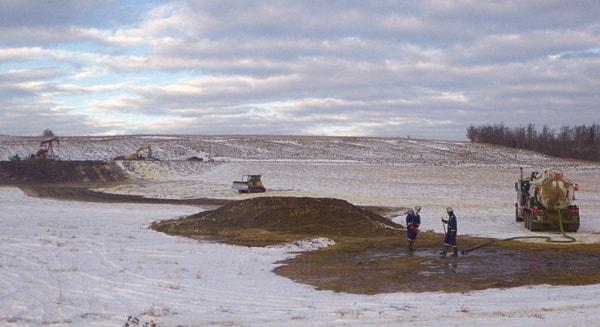The blowout of a oil well during a frac job on a neighbouring well in Red Deer County on Friday is raising nervous questions among rural landowners.
Norman Waters had just arrived home from work in Innisfail at 5 p.m. on Friday when be noticed a plume of black fluid spewing from a pump jack operating part way up a hill in his neighbour’s field, located less than one kilometre southwest of the point where the Red Deer River flows into the Gleniffer Lake reservoir.
On the other side of the hill, a crew from Canyon Technical Services was conducting a hydraulic frac in a well operated by Calgary-based Midway Energy Ltd.
Waters drove to the site and asked them to shut down the frac.
He then started calling emergency numbers, including the one for Wildstream Exploration, the Calgary-based company whose well was spewing fluid.
Both wells are now shut down, preliminary investigation and cleanup are nearly complete and a thorough investigation was to start this morning, said Darin Barter, a communications official with the Energy Resources Conservation Board.
The first priority was to get the flow stopped and clean up the site, Barter said on Sunday.
With that done, the ERCB and the companies involved are now trying to determine exactly what went wrong.
Early examination of the spilled fluid indicates a mix of oil, nitrogen and frac sand, said Barter.
However, the investigation has just begun, so there is possibility that other findings may contradict any assumptions made in the beginning, he said.
Both wells will remain shut in while investigators determine how pressurized fluid from the frac was able to breach the Wildstream well bore and whether or where miscalculations were made during the drilling and servicing processes. It will also determine if changes need to be made in the regulations governing those processes, said Barter.
Frozen ground has been a benefit to the site cleanup, preventing the spilled fluid from seeping into the soil while no fluid made it to the river, he said.
Professional engineer Shane Peet, chief operating officer for Midway, said the fracking crew was in stage 15 of a 16-stage frac on his company’s well when it appears to have “communicated with” the Wildstream well at a depth of 1,850 metres.
Peet believes that pressure from the frac drove reserves in Wildstream’s well up to the surface, along with fracking sand and fluids.
Costs of the investigation itself are part of the job for government employees, said Barter.
Midway will be responsible for cleanup costs and damages, including compensation to the landowner, said Peet.
Waters said he also called retired oilfield engineer Don Bester, president of the Alberta Surface Rights Group, because he wanted to know his rights as a landowner in relation to the spill, even though it occurred in his neighbour’s pasture.
Bester and other members of the group visited and photographed the site on Saturday morning.
The big issue for landowners is the potential for hydraulic fracking to damage the fresh water aquifers from which they draw their water, Bester said on Sunday.
Midway’s well bore would not likely have connected with Wildstream’s bore, but that there could be natural fractures within the formation that would have allowed the pressure from fracking one well to blow out the other, he said.
However, he wonders how many similar spills have gone unreported because they are held within the sites of the companies running the fracs and are therefore not brought to the public’s attention.
“If these companies can’t control these fracs, what is the potential to destroy a complete aquifer? We’re not convinced that these fracs will stay in the formation that they were intended to frac.”
Destroying an aquifer would destroy fresh water sources for hundreds of farmers, said Bester.
“What are we doing here, really? What are we doing?” he said.
Bester also said he also has questions about whether the plume sprayed over the bank and into the river.
“When you can see oil dripping from the trees, you know d..n well what happened over the bank.”
He and his companions did not go to the river because they would have had to cross private property without permission.
bkossowan@www.reddeeradvocate.com
